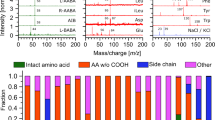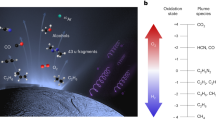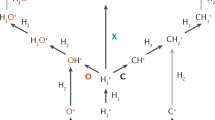Abstract
Laser desorption mass spectrometry (LDMS) enables in situ characterization of the organic content and chemical composition of planetary materials without requiring extensive sample processing. Coupled with an Orbitrap analyser capable of ultrahigh mass-resolving powers and accuracies, LDMS techniques facilitate the orthogonal detection of a wide range of biomarkers and classification of host mineralogy. Here an Orbitrap LDMS instrument that has been miniaturized for planetary exploration is shown to meet the performance standards of commercial systems and exceed key figures of merit of heritage spaceflight technologies, including those baselined for near-term mission opportunities. Biogenic compounds at area densities relevant to prospective missions to ocean worlds are identified unambiguously by redundant measurements of molecular ions (with and without salt adducts) and diagnostic fragments. The derivation of collision cross-sections serves to corroborate assignments and inform on molecular structure. Access to trace elements down to parts per million by weight levels provide insights into sample mineralogy and provenance. These analytical capabilities position the miniaturized LDMS described here for a wide range of high-priority mission concepts, such as those focused on life detection objectives (for example, Enceladus Orbilander) and progressive exploration of the lunar surface (for example, via the NASA Artemis Program).
This is a preview of subscription content, access via your institution
Access options
Access Nature and 54 other Nature Portfolio journals
Get Nature+, our best-value online-access subscription
$29.99 / 30 days
cancel any time
Subscribe to this journal
Receive 12 digital issues and online access to articles
$119.00 per year
only $9.92 per issue
Buy this article
- Purchase on Springer Link
- Instant access to full article PDF
Prices may be subject to local taxes which are calculated during checkout





Similar content being viewed by others
Data availability
Source data are provided with this paper. All other data presented in this study are available in the Supplementary Information.
References
Johnson, S. S., Anslyn, E. V., Graham, H. V., Mahaffy, P. R. & Ellington, A. D. Fingerprinting non-terran biosignatures. Astrobiology 18, 915–922 (2018).
Marshall, S. M., Murray, A. R. G. & Cronin, L. A probabilistic framework for identifying biosignatures using Pathway Complexity. Philos. Trans. R. Soc. Lond. A 375, 20160342 (2017).
Chan, M. A. et al. Deciphering biosignatures in planetary contexts. Astrobiology 19, 1075–1102 (2019).
Neveu, M., Hays, L. E., Voytek, M. A., New, M. H. & Schulte, M. D. The ladder of life detection. Astrobiology 18, 1375–1402 (2018).
Lukmanov, R. A. et al. On topological analysis of fs-LIMS data. Implications for in situ planetary mass spectrometry. Front. Artif. Intell. https://doi.org/10.3389/frai.2021.668163 (2021).
Johnston, S., Gehrels, G., Valencia, V. & Ruiz, J. Small-volume U–Pb zircon geochronology by laser ablation-multicollector-ICP-MS. Chem. Geol. 259, 218–229 (2009).
Sagdeev, R. Z. & Zakharov, A. V. Brief history of the Phobos mission. Nature 341, 581–585 (1989).
Managadze, G. G. et al. Study of the main geochemical characteristics of Phobos’ regolith using laser time-of-flight mass spectrometry. Sol. Syst. Res. 44, 376–384 (2010).
Goesmann, F. et al. The Mars Organic Molecule Analyzer (MOMA) instrument: characterization of organic material in Martian sediments. Astrobiology 17, 655–685 (2017).
Grubisic, A. et al. Laser desorption mass spectrometry at Saturn’s moon Titan. Int. J. Mass Spectrom. 470, 116707 (2021).
Chumikov, A. E., Cheptsov, V. S., Managadze, N. G. & Managadze, G. G. LASMA-LR laser-ionization mass spectrometer onboard Luna-25 and Luna-27 missions. Sol. Syst. Res. 55, 550–561 (2021).
Briois, C. et al. Orbitrap mass analyser for in situ characterisation of planetary environments: performance evaluation of a laboratory prototype. Planet. Space Sci. 131, 33–45 (2016).
Willhite, L. et al. CORALS: a laser desorption/ablation Orbitrap mass spectrometer for in situ exploration of Europa. In 2021 IEEE Aerospace Conference 50100, 1–13 (2021).
Makarov, A. A. Mass spectrometer US patent 5,886,346 (1999).
Arevalo, R. Jr, Ni, Z. & Danell, R. M. Mass spectrometry and planetary exploration: a brief review and future projection. J. Mass Spectrom. 55, e4454 (2020).
Makarov, A. Electrostatic axially harmonic orbital trapping: a high-performance technique of mass analysis. Anal. Chem. 72, 1156–1162 (2000).
Arevalo, R. Jr et al. An Orbitrap-based laser desorption/ablation mass spectrometer designed for spaceflight. Rapid Commun. Mass Spectrom. https://doi.org/10.1002/rcm.8244 (2018).
Yu, A. W. et al. The Lunar Orbiter Laser Altimeter (LOLA) laser transmitter. In 2011 IEEE International Geoscience and Remote Sensing Symposium 3378–3379 (2011).
Malloci, G., Mulas, G. & Joblin, C. Electronic absorption spectra of PAHs up to vacuum UV. Astron. Astrophys. 426, 105–117 (2004).
Cloutis, E. A. et al. Ultraviolet spectral reflectance properties of common planetary minerals. Icarus 197, 321–347 (2008).
Fahey, M. et al. Ultraviolet laser development for planetary lander missions. In 2020 IEEE Aerospace Conference 1–11 (2020).
Büttner, A. et al. Optical design and characterization of the MOMA laser head flight model for the ExoMars 2020 mission. In Proc. SPIE 11180, International Conference on Space Optics—ICSO 2018, 111805H (12 July 2019); https://doi.org/10.1117/12.2536116
Jenner, F. E. & O’Neill, H. S. C. Major and trace analysis of basaltic glasses by laser-ablation ICP-MS. Geochem. Geophys. Geosyst. https://doi.org/10.1029/2011GC003890 (2012).
Humayun, M., Davis, F. A. & Hirschmann, M. M. Major element analysis of natural silicates by laser ablation ICP-MS. J. Anal. Spectrom. 25, 998–1005 (2010).
Longerich, H. P., Günther, D. & Jackson, S. E. Elemental fractionation in laser ablation inductively coupled plasma mass spectrometry. Fresenius J. Anal. Chem. 355, 538–542 (1996).
Alterman, M. A., Gogichayeva, N. V. & Kornilayev, B. A. Matrix-assisted laser desorption/ionization time-of-flight mass spectrometry-based amino acid analysis. Anal. Biochem. 335, 184–191 (2004).
Sarracino, D. & Richert, C. Quantitative MALDI-TOF MS of oligonucleotides and a nuclease assay. Bioorg. Med. Chem. Lett. 6, 2543–2548 (1996).
Chumbley, C. W. et al. Absolute quantitative MALDI imaging mass spectrometry: a case of rifampicin in liver tissues. Anal. Chem. 88, 2392–2398 (2016).
Zubarev, R. A. & Makarov, A. Orbitrap mass spectrometry. Anal. Chem. 85, 5288–5296 (2013).
Makarov, A., Denisov, E., Lange, O. & Horning, S. Dynamic range of mass accuracy in LTQ Orbitrap hybrid mass spectrometer. J. Am. Soc. Mass Spectrom. 17, 977–982 (2006).
Hoegg, E. D. et al. Isotope ratio characteristics and sensitivity for uranium determinations using a liquid sampling–atmospheric pressure glow discharge ion source coupled to an Orbitrap mass analyzer. J. Anal. Spectrom. 31, 2355–2362 (2016).
Hofmann, A. E. et al. Using Orbitrap mass spectrometry to assess the isotopic compositions of individual compounds in mixtures. Int. J. Mass Spectrom. 457, 116410 (2020).
Hardouin, J. Protein sequence information by matrix-assisted laser desorption/ionization in-source decay mass spectrometry. Mass Spectrom. Rev. 26, 672–682 (2007).
Franchi, M., Ferris, J. P. & Gallori, E. Cations as mediators of the adsorption of nucleic acids on clay surfaces in prebiotic environments. Orig. Life Evol. Biosph. 33, 1–16 (2003); https://doi.org/10.1023/A:1023982008714
Trumbo, S. K., Brown, M. E. & Hand, K. P. Sodium chloride on the surface of Europa. Sci. Adv. 5, eaaw7123 (2019).
Postberg, F., Schmidt, J., Hillier, J. et al. A salt-water reservoir as the source of a compositionally stratified plume on Enceladus. Nature 474, 620–622 (2011).
De Sanctis, M. C. et al. Fresh emplacement of hydrated sodium chloride on Ceres from ascending salty fluids. Nat. Astron. 4, 786–793 (2020).
Hand, K. P. et al. Report of the Europa Lander Science Definition Team (NASA, 2017).
Hendrix, A. R. et al. The NASA Roadmap to Ocean Worlds. Astrobiology 19, 1–27 (2018); https://doi.org/10.1089/ast.2018.1955
MacKenzie, S. M. et al. The Enceladus Orbilander mission concept: balancing return and resources in the search for life. Planet. Sci. J. 2, 77 (2021).
Waite, J. H. Jr et al. Liquid water on Enceladus from observations of ammonia and 40Ar in the plume. Nature 460, 487–490 (2009).
Altwegg, K., Balsiger, H. & Fuselier, S. A. Cometary chemistry and the origin of icy solar system bodies: the view after Rosetta. Annu. Rev. Astron. Astrophys. 57, 113–155 (2019).
Guzman, M. et al. Collecting amino acids in the Enceladus plume. Int. J. Astrobiol. 18, 47–59 (2018).
Takayama, M. In-source decay characteristics of peptides in matrix-assisted laser desorption/ionization time-of-flight mass spectrometry. J. Am. Soc. Mass Spectrom. 12, 420–427 (2001).
Katta, V., Chow, D. T. & Rohde, M. F. Applications of in-source fragmentation of protein ions for direct sequence analysis by delayed extraction MALDI-TOF mass spectrometry. Anal. Chem. 70, 4410–4416 (1998).
Sanders, J. D. et al. Determination of collision cross-sections of protein ions in an Orbitrap mass analyzer. Anal. Chem. 90, 5896–5902 (2018).
Makarov, A. & Denisov, E. Dynamics of ions of intact proteins in the Orbitrap mass analyzer. J. Am. Soc. Mass Spectrom. 20, 1486–1495 (2009).
Anupriya, Jones, C. A. & Dearden, D. V. Collision cross sections for 20 protonated amino acids: Fourier transform ion cyclotron resonance and ion mobility results. J. Am. Soc. Mass Spectrom. 27, 1366–1375 (2016).
Chyba, C. & Sagan, C. Endogenous production, exogenous delivery and impact-shock synthesis of organic molecules: an inventory for the origins of life. Nature 355, 125–132 (1992).
Poppe, A. R. An improved model for interplanetary dust fluxes in the outer Solar System. Icarus 264, 369–386 (2016).
Taylor, S. R. & McLennan, S. M. in Handbook on the Physics and Chemistry of Rare Earths Vol. 11, 485–578 (eds Gschneidner, K. A. J. & Eyring, l.) (Elsevier, 1988).
Jawin, E. R. et al. Lunar science for landed missions workshop findings report. Earth Space Sci. 6, 2–40 (2019).
National Academies of Sciences, Engineering, and Medicine. Origins, Worlds, and Life: A Decadal Strategy for Planetary Science and Astrobiology 2023–2032 (National Academies Press, 2022).
Artemis III Science Definition Team Report (NASA, 2020).
Steinbrügge, G. et al. Brine migration and impact-induced cryovolcanism on Europa. Geophys. Res. Lett. 47, e2020GL090797 (2020).
Danell, R. et al. A full featured, flexible, and inexpensive 2D and 3D ion trap control architecture and software package. In Proc. 58th ASMS Conference on Mass Spectrometry and Allied Topics 283889 (2010).
Acknowledgements
This study was supported by the University of Maryland Faculty Incentive Program (PI: R.A. Jr), NASA Goddard Space Flight Center Internal Research and Development Program (PIs: A.G. and A.Y.), NASA ROSES ICEE 2 Grant 80NSSC19K0610 (PI: R.A. Jr), ROSES DALI Grant 80NSSC19K0768 (PI: R.A. Jr) and CRESST II Award Number 80GSFC21M0002 (PI: A.S.).
Author information
Authors and Affiliations
Contributions
The dataset presented in this study was collected and analysed by R.A. Jr, L.W., A.B., Z.N. and S.R. The system-level architecture of the miniaturized instrument and the operational sequence of the experiments conducted were defined by R.A. Jr, A.S., R.D., A.G., C.B., L.T., F.C. and A.M. Requirements for the ion optics and SIMION models of ion transmission were provided by A.S. The mechanical design of the mass analyser assembly and custom series of ion optics were led by C.G. and N.M. The design and build of the prototype UV laser system was led by A.Y. and M.F. All authors contributed to the interpretation of the results and editing of the manuscript.
Corresponding author
Ethics declarations
Competing interests
A.M. is an employee of Thermo Fisher Scientific, the manufacturer of the Orbitrap device leveraged in the miniaturized instrument described here.
Peer review
Peer review information
Nature Astronomy thanks Marek Tulej and the other, anonymous, reviewer(s) for their contribution to the peer review of this work.
Additional information
Publisher’s note Springer Nature remains neutral with regard to jurisdictional claims in published maps and institutional affiliations.
Supplementary information
Supplementary Information
Supplementary discussion, Figs. 1–8 and Table 1.
Source data
Source Data Fig. 2
Raw time domain transients for Fig. 2.
Source Data Fig. 3
Raw time domain transient for Fig. 3.
Source Data Fig. 5
Raw time domain transient for Fig. 5.
Rights and permissions
Springer Nature or its licensor (e.g. a society or other partner) holds exclusive rights to this article under a publishing agreement with the author(s) or other rightsholder(s); author self-archiving of the accepted manuscript version of this article is solely governed by the terms of such publishing agreement and applicable law.
About this article
Cite this article
Arevalo, R., Willhite, L., Bardyn, A. et al. Laser desorption mass spectrometry with an Orbitrap analyser for in situ astrobiology. Nat Astron 7, 359–365 (2023). https://doi.org/10.1038/s41550-022-01866-x
Received:
Accepted:
Published:
Issue Date:
DOI: https://doi.org/10.1038/s41550-022-01866-x
This article is cited by
-
Tunable Laser Spectrometers for Planetary Science
Space Science Reviews (2023)



